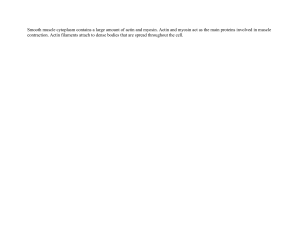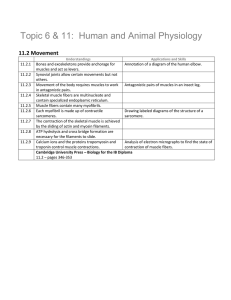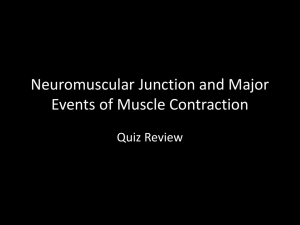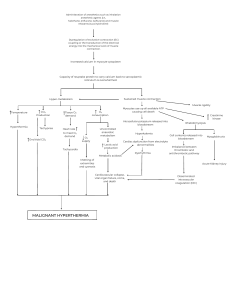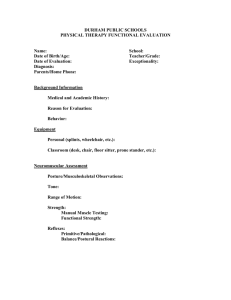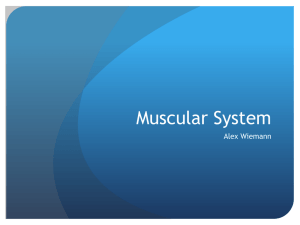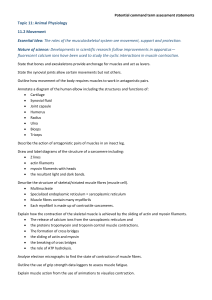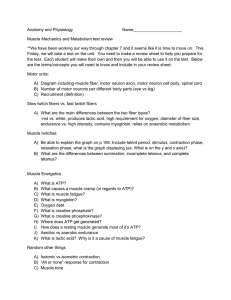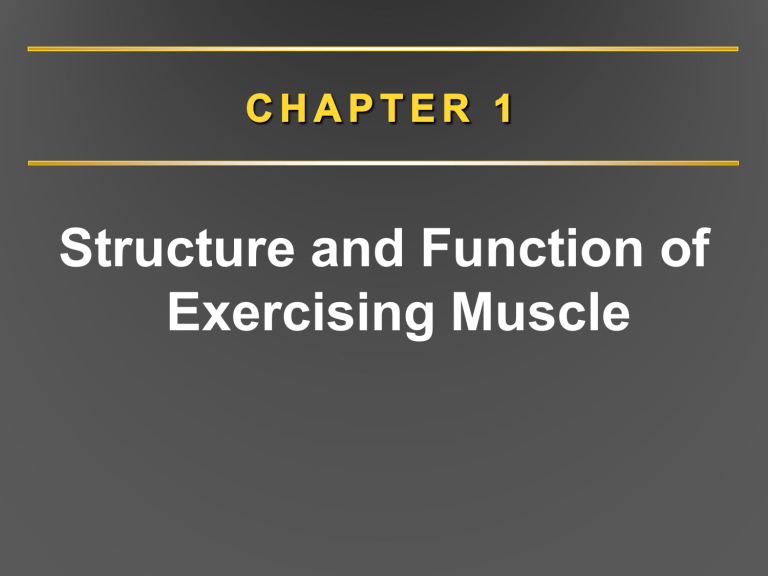
Structure and Function of Exercising Muscle CHAPTER 1 Overview • Functional anatomy of skeletal muscle – Muscle fiber – Myofibril – Muscle fiber contraction • Skeletal muscle and exercise – Muscle fiber types – Muscle fiber (motor unit) recruitment – Orderly recruitment of muscle fibers (size principle) – Fiber type and athletic success Three Types of Muscle Tissue • Smooth muscle: involuntary, hollow organs blood vessels, digestive tract, urine expel, contract and relax.(control by nerve and endocrine)sympathetic and parasympathetic; epinephrine and norepinephrine • Cardiac muscle: involuntary, heart controls by nervous and endocrine systems • Skeletal muscle: voluntary, skeleton together with skeleton, make up musculoskeletal system,600 skeletal muscles, exercise and human activity of daily. Thumb controled by nine separate muscles, fine activity. Figure 1.1 Figure 1.2 the basic structure of muscle Skeletal Muscle Anatomy fig1.2 • Entire muscle – Surrounded by epimysium – Consists of many bundles (fasciculi)纖维束 • Fasciculi(fascile) – Surrounded by perimysium – Consists of individual muscle cells (muscle fibers) • Muscle fibers – Surrounded by endomysium – Each fiber consists of myofibrils divided into sarcomeres • Sarcomeres is the basic functional unit of the myofibril(activity,involved muscle’s contraction ) fig1.5 Structure of Muscle Fibers fig1.3 • Plasmalemma(plasma membrane) Fuses with tendon(collagen vs vitamin C and tendon injury) – Conducts action potential (motor end plate) – Maintains pH, transports nutrients (capillary blood) • Satellite cells (between plasmalemma and basement) – Muscle growth, development – Response to injury, immobilization, training Structure of Muscle Fibers fig 1.3 • Sarcoplasm – Cytoplasm of muscle cell, gelatin-like substance between myofibril – Dissolved protein, minerals, glycogen, fats, and necessary organelles, and myoglobin. • Transverse tubules (T-tubules) – Extensions of plasmalemma 附屬深入 – Carry action potential deep into muscle fiber, enable substance to enter the cell and waste products leave the fiber. – Sarcoplasmic reticulum (SR): Ca2+ storage Figure 1.3 • Muscle changes after only 6 weeks of training. • 4 week detraining the muscle will atrophy • Weight training is important for strong you muscle, will prevent injury of muscle • Weight training is a proper rehabilitation programs • Muscle weight will lose in aging, the metabolism will slow down, cho, fat and protein metabolism will change in aging. Myofibrils and Sarcomeres fig1.5 • Myofibrils – Muscle(epi) fasciculi(peri) muscle fiber(endo) myofibril – Hundreds to thousands per muscle fiber • Sarcomeres(fig 1.5) – Basic contractile element of skeletal muscle – End to end for full myofibril length at Z-disks Figure 1.5 Figure 1.4 blue A-band, pink I-band Sarcomeres fig 1.5 • Distinctive striped appearance (striations) – – – – A-bands: dark stripes I-bands: light stripes H-zone: middle of A-band(between actin) M-line: middle of H-zone • Common boundary structure: Z-disk Sarcomere: Protein Filaments • Used for muscle contraction • Actin (thin filaments) – Show up lighter under microscope – I-band contains only actin filaments • Myosin (thick filaments) – Show up darker under microscope – A-band contains both actin and myosin filaments – H-zone contains only myosin filaments Myosin (thick filaments) • Two intertwined filaments with globular heads • Globular heads – Protrude 360° from thick filament axis – Will interact with actin filaments for contraction • Stabilized by titin Actin (thin filaments) • Actually composed of three proteins – Actin: contains myosin-binding site – Tropomyosin: covers active site at rest – Troponin: anchored to tropomyosin , moves tropomyosin (Ca+ bind site) • Anchored at Z-disk • Equally spaced out by titin(eccentric contraction easy by titin) • Nebulin is an anchor protein for actin fig1.5 ACTIN FILAMENT Figure 1.5 Motor Units fig1.6 • a-Motor neurons innervate muscle fibers • Motor unit – Single a-motor neuron + all fibers it innervates – More operating motor units = more contractile force – Synapse fig1.7a is the site of communication between neuron and a muscle fiber – Consists of synapse between a-motor neuron and muscle fiber Figure 1.6 Synapse(the site between neuron and muscle fiber ach exchange) Synapse a part of motor end plate Skeletal Muscle Contraction (excitation-contraction coupling) fig1.7 1. Action potential (AP) starts in brain 2. AP arrives at axon terminal, releases acetylcholine (ACh)(skeletal muscle) 3. ACh crosses synapse, binds to ACh receptors on plasmalemma 4. AP travels down plasmalemma, T-tubules 5. Triggers Ca2+ release from sarcoplasmic reticulum(SR) 6. Ca2+ enables actin-myosin contraction Figure 1.7 Role of Ca2+ in Muscle Contraction • AP arrives at SR from T-tubule – SR sensitive to electrical charge – Causes mass release of Ca2+ into sarcoplasm • Ca2+ binds to troponin on thin filament – At rest, tropomyosin covers myosin-binding site, blocking actin-myosin attraction – Troponin-Ca2+ complex moves tropomyosin (appear active site) – Myosin head (cross bridges) binds to actin active site, contraction can occur Sliding Filament Theory: How Muscles Create Movement Figure 1.8 • Process of actin-myosin contraction • Relaxed state – No actin-myosin interaction at binding site – Myofilaments overlap a little • Contracted state – Myosin head pulls actin toward sarcomere center (power stroke) – Filaments slide past each other – Sarcomeres, myofibrils, muscle fiber all shorten Figure 1.8 Sliding Filament Theory: How Muscles Create Movement • After power stroke ends (one complete pull fig 1.9-1.2. ) – Myosin head detaches from active site – Myosin head rotates back to original position – Myosin attaches to another active site farther down • Process continues until – Z-disk reaches myosin filaments or – AP stops, Ca2+ gets pumped back into SR Figure 1.9 Energy for Muscle Contraction • Adenosine triphosphate(ATP) • Binds to myosin head – ATPase on myosin head – ATP ADP + Pi + energy • Necessary for muscle contraction Muscle Relaxation • AP ends, electrical stimulation of SR stops • Ca2+ pumped back into SR – Stored until next AP arrives – Requires ATP • Without Ca2+, troponin and tropomyosin return to resting conformation – Covers myosin-binding site – Prevents actin-myosin cross-bridging Muscle Fiber Types • Type I – ~50% of fibers in an average muscle – Peak tension in 110 ms (slow twitch;red) • Type II – Peak tension in 50 ms (fast twitch ;white) – Type IIa (~25% of fibers in an average muscle) – Type IIx (~25% of fibers in an average muscle) Figure 1.10(I black, IIa white, IIx gray) Type I Versus Type II Differentiation • Speed of myosin ATPase varies – Fast myosin ATPase = fast contraction cycling – Slower myosin ATPase = slower contraction cycling • Muscle biopsy – Small (10-100 g) piece of muscle removed – Frozen, sliced, examined under microscope • Gel electrophoresis(molecule weight) fig 1.11 – Type I versus II fibers have different types of myosin – Separates different types of myosin by size Muscle Biopsy Figure 1.11 Type I Versus Type II • Sarcoplasmic reticulum – Type II fibers have a more highly developed SR – Faster Ca2+ release, 3 to 5 times faster Vo (speed con-) • Motor units – Type I motor unit: smaller neuron, <300 fibers – Type II motor unit: larger neuron, >300 fibers Type I Versus Type II: Peak Power • Peak power: type IIx > type IIa > type I – Effects of different SR, motor units, etc. – Single muscle fiber recording, next slide Single Muscle Fiber Peak Power Table 1.1 Distribution of Fiber Types: Type I:Type II Ratios • Each person has different ratios genetic determinants • Arm and leg ratios are similar in one person – Endurance athlete: type I predominates – Power athlete: type II predominates • Soleus: type I in everyone 比目魚肌 Type I Fibers During Exercise • High aerobic endurance – Can maintain exercise for prolonged periods – Require oxygen for ATP production – Low-intensity aerobic exercise, daily activities • Efficiently produce ATP from fat, carbohydrate next chapter! Type II Fibers During Exercise • Type II fibers in general(無氧運動) – Poor aerobic endurance, fatigue quickly – Produce ATP anaerobically • Type IIa(肌耐力運動) – More force, faster fatigue than type I – Short, high-intensity endurance events (800-1,600 m run) • Type IIx(肌力運動) – Seldom used for everyday activities – Short, explosive sprints (100 m)緊急事件動用 Table 1.2 Fiber Type Determinants • Genetic factors – Determine which a-motor neurons innervate fibers – Fibers differentiate based on a-motor neuron • Training factors – Endurance versus strength training, detraining – Can induce small (10%) change in fiber type • Aging: muscles lose type II motor units(老年人 重量訓練的重要性) Muscle Fiber Recruitment • Also called motor unit recruitment • Method for altering force production – Less force production: fewer or smaller motor units – More force production: more or larger motor units – Type I motor units smaller than type II • Recruitment order: type I, type IIa, type IIx Orderly Recruitment and the Size Principle • Recruit minimum number of motor units needed – Smallest (type I) motor units recruited first – Midsized (type IIa) motor units recruited next – Largest (type IIx) motor units recruited last • Recruited in same order each time • Size principle: order of recruitment of motor units directly related to size of a-motor neuron(smallest to largest motor neuron) Fiber Type and Athletic Success (table1.3) • Endurance athletes—type I predominates • Sprinters—type II predominates • Fiber type(muscle) not sole predictor of success – – – – Cardiovascular function Motivation Training habits Muscle size Types of Muscle Contraction • Static (isometric) contraction – Muscle produces force but does not change length – Joint angle does not change – Myosin cross-bridges form and recycle, no sliding (reviewed fig 1.9 touch 1 more times) the length of sarcomere unchange!power strike no1 repeated • Dynamic contraction(concentric and eccentric contraction) – Muscle produces force and changes length – Joint movement produced Dynamic Contraction Subtypes • Concentric contraction – Muscle shortens while producing force(to heart)肢體移動方向 – Most familiar type of contraction – Sarcomere shortens, filaments slide toward center • Eccentric contraction – Muscle lengthens while producing force(away from heart)肢 體移動方向 – Cross-bridges form but sarcomere lengthens – Example: lowering heavy weight baseball left hand Generation of Force • Motor unit recruitment – Type II motor units = more force – Type I motor units = less force – Fewer small fibers versus more large fibers • Frequency of stimulation (fig1.12) – Twitch(a motor unit to a single electrical stimulus) – Summation(three stimuli in rapid sequence, great force) – Tetanus(continued stimulation at higher frequency) Figure 1.12 Generation of Force • Length-tension relationship (fig 1.13) – Optimal sarcomere length = optimal overlap – Too short or too stretched = little or no force develops Figure 1.13 sarcomere length and force單一肌節 Generation of Force – Speed-force relationship (fig 1.14) – Concentric: maximal force development decreases at higher speeds – Eccentric: maximal force development increases at higher speeds – Concentric dominates slow speeds, eccentric dominates high speeds Figure 1.14
